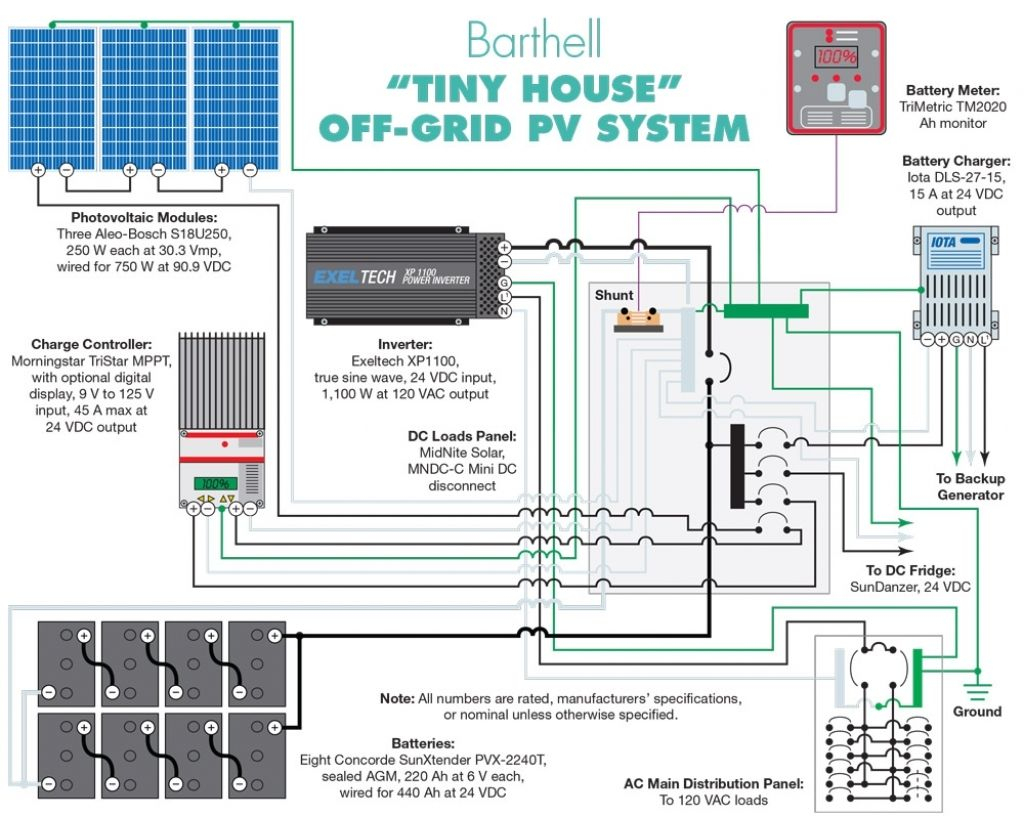“Off-grid solar panel to inverter wiring”
Introduction to Off-Grid Solar Panel Systems
Off-grid solar panel systems, also known as standalone or autonomous systems, are designed to operate independently of the grid. They typically consist of solar panels, a battery bank, a charge controller, and an inverter. The solar panels generate DC (direct current) electricity, which is then stored in the battery bank. The charge controller regulates the flow of energy to and from the battery bank, while the inverter converts the DC power into AC (alternating current) electricity, which is usable by most household appliances.
Wiring Components and Considerations
When it comes to wiring an off-grid solar panel system, several components and considerations come into play. These include:
- Solar Panels: Solar panels are the primary source of energy in an off-grid system. They are typically connected in series and/or parallel to achieve the desired voltage and current.
- Battery Bank: The battery bank stores excess energy generated by the solar panels during the day for use at night or during periods of low sunlight. Battery banks can be configured in series, parallel, or a combination of both.
- Charge Controller: The charge controller regulates the flow of energy to and from the battery bank, preventing overcharging or undercharging.
- Inverter: The inverter converts DC power from the battery bank into AC electricity, which is usable by most household appliances.
- Wiring and Cables: The wiring and cables used to connect the components must be sized and rated for the system’s voltage and current requirements.
- Fuses and Circuit Breakers: Fuses and circuit breakers provide protection against overcurrent conditions and short circuits.

Wiring Configurations
Off-grid solar panel systems can be wired in various configurations, depending on the specific requirements of the system. Some common wiring configurations include:
- Series Wiring: Solar panels are connected in series to achieve a higher voltage. This configuration is suitable for systems with a high voltage requirement, such as those with a 24V or 48V battery bank.
- Parallel Wiring: Solar panels are connected in parallel to achieve a higher current. This configuration is suitable for systems with a high current requirement, such as those with a large battery bank.
- Series-Parallel Wiring: Solar panels are connected in a combination of series and parallel to achieve the desired voltage and current.

Inverter Wiring

The inverter is a critical component in an off-grid solar panel system, as it converts DC power into AC electricity. When it comes to wiring the inverter, several considerations must be taken into account:
- Inverter Input: The inverter input must be connected to the battery bank, taking into account the system’s voltage and current requirements.
- Inverter Output: The inverter output must be connected to the load center or distribution panel, which distributes the AC electricity to the various appliances and devices.
- Grounding: The inverter must be properly grounded to ensure safe operation and prevent electrical shock.
Best Practices for Off-Grid Solar Panel to Inverter Wiring
To ensure a safe and efficient connection between the solar panels and the inverter, several best practices should be followed:
- Use Properly Sized Wiring: Use wiring and cables that are sized and rated for the system’s voltage and current requirements.
- Follow Manufacturer Guidelines: Follow the manufacturer’s guidelines for wiring and configuring the solar panels, charge controller, and inverter.
- Use Fuses and Circuit Breakers: Use fuses and circuit breakers to provide protection against overcurrent conditions and short circuits.
- Ensure Proper Grounding: Ensure that the system is properly grounded to prevent electrical shock and ensure safe operation.
- Use a Wiring Diagram: Create a wiring diagram to visualize the system’s wiring configuration and ensure that all components are properly connected.
Safety Considerations
When working with electrical systems, safety is paramount. Several safety considerations must be taken into account when wiring an off-grid solar panel system:
- Electrical Shock: Electrical shock can occur when working with live electrical components. Ensure that all components are properly grounded and that you follow proper safety procedures when working with electrical systems.
- Fire Risk: Fire risk can occur when using faulty or damaged wiring and components. Ensure that all components are properly sized and rated for the system’s voltage and current requirements.
- Overcurrent Conditions: Overcurrent conditions can occur when the system is not properly configured or when a fault occurs. Use fuses and circuit breakers to provide protection against overcurrent conditions.
Conclusion
Off-grid solar panel to inverter wiring requires careful consideration of several components and configurations. By following best practices and taking into account safety considerations, individuals can ensure a safe and efficient connection between the solar panels and the inverter. Whether you’re a seasoned professional or a DIY enthusiast, understanding the fundamentals of off-grid solar panel to inverter wiring is crucial for a successful and reliable system. As the world continues to shift towards renewable energy sources, the importance of proper wiring and configuration will only continue to grow.
Recommendations for Future Projects
For future off-grid solar panel projects, consider the following recommendations:
- Use High-Efficiency Components: Use high-efficiency components, such as solar panels and inverters, to maximize energy production and minimize energy losses.
- Monitor and Maintain the System: Regularly monitor and maintain the system to ensure optimal performance and prevent faults.
- Consider Energy Storage: Consider adding energy storage, such as a battery bank, to store excess energy generated during the day for use at night or during periods of low sunlight.
- Consult with a Professional: Consult with a professional if you’re unsure about any aspect of the system’s design or installation.
By following these recommendations and best practices, individuals can ensure a safe, efficient, and reliable off-grid solar panel system that meets their energy needs and reduces their reliance on the grid.





